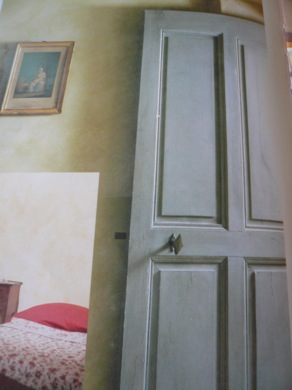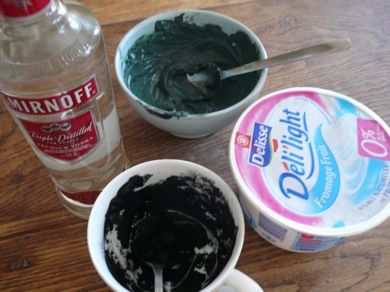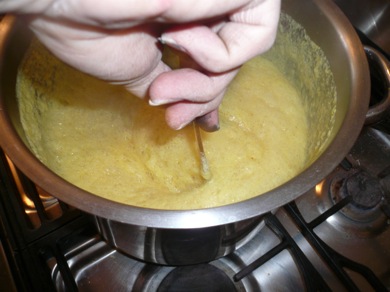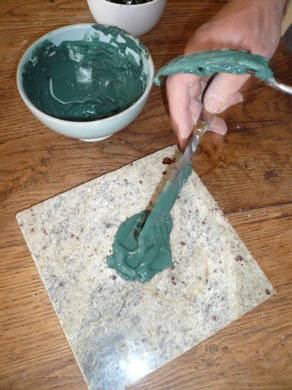The Green Door

On page 98 of our ‘Ocres et Peintures Décoratives de Provence’ there is picture of a grey-green door. I fell in love with it the instant I saw it and I vowed that, if the day ever came when I had a room of my own, this door would be its door. In fact, it was the first door that had excited me since my parents painted my bedroom door pink and green candy stripes for my fourteenth birthday.
Although it would be three years until I got to paint my door, I bought the pigments – terre verte and noir fumé, a grown up version of pink and green perhaps? – on the spot.
The day has now come, and we set about trying to assemble the ingredients for green-grey wax paint:
Fromage Blanc 0% Fat
Ammonium
Beeswax
Ammonium carbonate
Distilled water
Alcohol

Trying to get hold of ammonium carbonate was hard. I finally ordered it from the village chemist who handed it to me double-wrapped and at arms length, her nose in an exaggerated snub, like a stink-bomb. Then I found that the bottle of alcohol I use to clean my fingerboard was empty (something to do with cleaning dried paint off the artist's palette perhaps?), and replacing that (to dissolve the ‘noir fumé’ which is not an earth pigment and is therefore not water-soluble) on a Sunday morning in Bedoin turned out, especially with a hangover, to be a thankless task. I ended up in ‘Petit Casino’ listening to the serveuse’ recipe for preserved cherries for ten minutes before emerging with one arm full of feminine hygene products whilst the other clutched a bottle of Smirnoff. It was not a moment in which I felt especially kind towards the environment and I could have done with some cover. Anyway, if the Vodka didn’t work, I thought, it was still good for removing red wine stains.
We started to follow the recipe.
‘Wax and fromage blanc make a very happy marriage, used traditionally to paint troikas’ the book said. It was, for the moment at least, all rather romantic.

We added a teaspoon of ammonium to the fromage blanc to make casein and the romance was suddenly over. The pong seared through our airways and caused Manon and Oscar to evacuate the premises. Melting the beeswax with the water and inhaling the sweet amber syrup proved a much needed antidote to the ammonium but it was brief, and when we added the ammonium carbonate to the melted wax (this apparently creates a cream which enables the wax to be worked with when cold) we were engulfed in a cloud like a chemistry experiment gone wrong that jolted us out of our honeyed reverie.
"I'm not sure about how environmentally friendly this natural paint is" I said. "This surely cannot be good for our health. I'm going back to Dulux magnolia"
We read on. ‘Casein is a very nervous glue, softened by wax….’. By now the wax, which we had been whisking, was cool and looked like curdled custard.

I was starting to feel a little nervous myself and luckily it was time for the fun bit - to mix the pigment. Using Julian’s palette knife we creamed up the green and black in equal parts with a little water on a granite tile, ironing out the marbled streaks and arriving at a deep grey green. We added everything together, presuming the colour would lighten as we applied it to the white wood.

Unfortunately, despite our dreams of a cloudy waxy surface, the door just turned out streaky black with grainy bits of wax sediment in it.
Julian assures me that, by adding ‘blanc de titane’, more green and reducing the black, with several applications, by polishing and sanding and with a lot more patience, I will get my perfect door.
‘It’s just like making frames.’ He said. You have to keep experimenting to find the right recipe; you have to apply several coats; you have to keep rubbing it down and polishing it up……’
(Is that why all our pictures remain unframed, I wondered)
Looking at my morbid door at the end of the day I did not feel like a teenager in her new den, nor did I feel like a Virginia Woolf heroine, but rather some sort of middle aged Goth.






6 Comments:
Ne t'inquiètes pas Ruth, tu vas y arriver à trouver la belle couleur gris vert...mais, c'est vrai qu'il faut un peu de patience et que, travailler avec les pigments procure des surprises...
De toute façon, c'est toujours intéressant de retrouver d'anciennes recettes de peinture, de les essayer et de voir les résultats...
Attention quand même de ne pas repeindre Manon et Oscar en gris vert à la caséine !!!
Amusez-vous bien et à très bientôt
I loved reading about this and I'm sure you will get it to just the right colour eventually - having all this history and painstaking process to remember every time you pass through the door will just increase its beauty for you (and, yes, avoid painting the cats, which I know from experience can be difficult!).
The color of the door in your picture is really lovely. I am sure you'll get it right eventually. It does sound like quite a complicated process you're using. It makes me feel lazy, just picking up a gallon of paint at the local home store. Good luck!
Thanks for your encouragement folks. Actually things have improved. It is now, after three coats, blue grey with a hint of over distressed black! The good news is that wire wool gets rid of the horrid noduley bits, and the wax shines up beautifully so when i am inspired again I will try for a greener grey. We are getting there!
The thought of your grumpy face in an impersonation of a middle aged Goth made me laugh out loud...thanks :) I was having a middle aged moment myself. However,I'm sure with perseverence you'll get it looking lovely..chin up youngster, go and listen to some Bauhuas!
Dear Ruth,
I couldn’t believe my luck at finding your blog. I have the very same book, I fell in love with the same door and am currently trying to reproduce the wax paint with the same grey-green colour. I thought someone out there could finally decipher the mystery! It seems, however, you were having some trial and error adventures, as I am now. I think part of the problem is that in this photo, we perceive the colour as grey-green, when in fact I am now convinced that it is the same grey-blue found on the closet doors of p.95. The light bouncing off the green walls in the surrounding room may be responsible for the illusion of a green hue.
When you add noir de fumée to white it makes, as you have noticed, a lovely blue-grey colour. The raw umber used in equal proportions gives the colour more of an earthy warm tone. Since grey is a tertiary colour, you could obtain a grey-green by mixing yellow, blue and red. In the case of this particular grey-green hue, we may have the most success with the following pigments: jaune citron, rouge Vénitian or rouge Anglais foncé (a cheaper and casein-suitable substitute for rouge garance, a red originally made from the dye of madder root – and the best colour for creating this grey-green) white, and blue céruleum; or you may use the following artist colours: Jaune citron, rose doré (alizarine), white and blue céruleum (use water based artist colours for this wax-casein paint and oil based for oil paints). The casein (fromage blanc à l’ammoniaque) in this paint recipe provides some of the white needed. You could also add more white pigment (i.e. titanium dioxide) or possibly blanc de Meudon, a white chalk used as filler/thickener in natural paints. Once all the ingredients are mixed, don’t forget to pass the paint through a large sieve (tamis).
It takes some time, as you know, to find the exact combination of pigments that produces the grey-green hue and tint we are looking for. I find it tedious but helpful to carefully record all quantities of pigments used as I proceed through the experiment. Nothing like finding the colour and then not being able to reproduce it! It is a good idea to create a colour chart on a piece of wood with numbered trial and errors corresponding to a list of the precise ratios of pigments used. You probably already know these things already. I am just writing what I myself am finding helpful in this learning process.
I order my pigments on-line or in person from a wonderful store in Bordeaux known as Matières et Couleurs (www.colorare.fr). They carry thousands of pigments, both natural and artificial; they also carry products such as carbonate d’ammonium, many natural and ecological pre-mixed lime plasters and paints (or their ingredients if you prefer to mix your own), casein paints, wax products, natural wood products, and so on. They offer relatively well-priced workshops compared to what is offered elsewhere. I’ve just discovered a store in Thivier (Dordogne) called Ecodéco (15 Rue Jean-Jaurès, tel: 05 53 55 13 61) that sells many of their products, including pigments. The owner also restores furniture with natural products and may be able to help you.
I wish you courage and patience to keep experimenting. Let us know how it turns out in the end! As I progress with my experiments, I would be happy to share the ratios of the pigments I used.
Note: Jaune citron pigment can be found at www.colorare by clicking “Pigments” and then “Beaux Arts Luxe.” You could also try a bright yellow ocre, such as Ocre Icles d’Italie - found under pigments and then “Terre, Ocres, Oxides”. Venitian and English red ocres are also found in this last category. The cerulean blue is found under “Pigments,” then “Deco: organique et minéraux”. The white is also found in the latter category, dioxide de titane being the most commonly used owing to its opacity. Blanc de meudon can be found by clicking “Charge” and then “Poudre de marbre/craie” and then “Craie”.
I've just noticed at the last minute the date of this page of from last year. Perhaps you have since arrived at the colour of your dreams. If so, I would love to hear about how you did it!
Post a Comment
<< Home